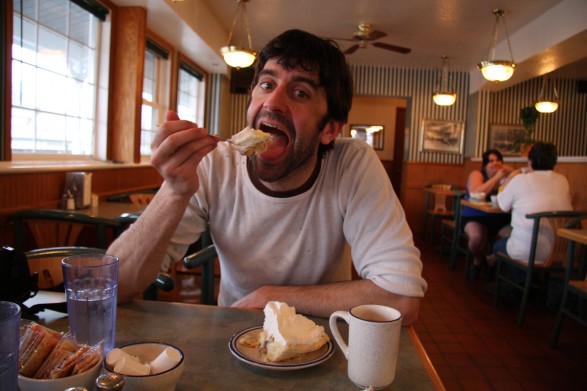Seven Question Interview with Matt McCormick, Portland-based Filmmaker and Artist

Matt McCormick is an ardent filmmaker and artist who resides in Portland, Oregon. He is an eminent maker in the avant-garde and independent sphere of cinema — voted one of the best filmmakers of the 21st century, according to a poll conducted by the Film Society of the Lincoln Center — Matt found early success with his well-known short The Subconscious Art of Graffiti Removal (2002, narrated by Miranda July), which was named in ‘Top 10 / Best of 2002’ lists in both The Village Voice and Art Forum magazine.
Matt collaborates with notable artists; Matt makes music videos for recognized bands: Broken Bells, The Shins, Miranda July, Sleater-Kinney, The Postal Service, YACHT, Al Burian, Eluvium, Patton Oswalt, and Calvin Johnson, to name a few.
Matt McCormick has an aptitude for successfully distributing his films, whether it be D.I.Y. and starting his own distribution label (Peripheral Produce) and founding the PDX Film Festival, or simply just making great work and having it exhibit in a theatre, gallery, or festival.
“Matt has had three films screen at the Sundance Film Festival, and has had work screened or exhibited at MoMA, The Serpentine Gallery, The Oslo Museum of Modern Art, the Reykjavik Art Museum, The Seattle Art Museum, and in 2007 he was selected to participate in both the Moscow Biennial and Art Basil. He has received awards including Best Short Film from the San Francisco International Film Fest, Best Experimental from the New York Underground Film Fest, and Best Narrative from the Ann Arbor Film Festival.
Matt’s debut feature film Some Days are Better Than Others premiered at SXSW and was invited to screen in the New Directors / New Films series presented by MoMA and the Film Society of Lincoln Center. Starring Carrie Brownstein and James Mercer, the film was acquired by Palisades Tartan and will be released theatrically in the spring of 2011.”
[vimeo http://vimeo.com/247752 w=587&h=440]
(1) During your early days of filmmaking, what were the challenges, and how did you surmount? What are the onerous aspects of the filmmaker’s journey?
I get the sense that the challenges never really cease. Even when I talk to my super successful filmmaker friends, I am always surprised to hear how difficult things can be. For me, the early challenges were as simple as getting access to equipment and finding venues that would screen my work. From there, the challenges largely became more internal — wanting to grow as an artist and make work that felt like a progression, or simply arranging your life so that the demands of filmmaking are not impeded on by other lifestyle choices. But I think the challenges are almost always there, from being frustrated because you want to make something, but lack the resources, to having made something, but being disappointed with how it turned out or was received. And then there is the whole “how am I going to make a living?” to boot. I think as a filmmaker, you just have to deal with it, and understand that there are challenges around every corner.
[vimeo http://vimeo.com/6645929 w=587&h=330]
(2) You recently completed your first feature film, Some Days are Better Than Others (2010), which stars James Mercer and Carrie Brownstein, and premiered at the 2010 SXSW. Please tell us of the process of making your first feature film — all the toil, from conception to distribution.
It was a long haul. I began writing the screenplay as far back as 2003 or so and got really serious about it in 2006. It was a multi-step process that ping-ponged back and forth between purely creative challenges, such as writing and casting, to much more business like challenges, such as finding investors and creating a foundation upon which to make the film. I suppose my big ‘break’ with the project came when producers David Cress and Neil Kopp approached me about making the film. With those guys on board we started the argues process of fund raising, and then eventually casting and production. It was amazing how slow it all felt for the first several years and then the explosion of productivity once the funding was secured and we actually went into pre-production and production.
[vimeo http://vimeo.com/19903220 w=587&h=330]
[vimeo http://vimeo.com/15191957 w=587&h=330]
(3) Additionally, you recently completed your first feature-length documentary, The Great Northwest. How does creating a feature-length documentary film compare to making a feature-length narrative film?
I wouldn’t really call The Great Northwest a “feature length documentary.” It is much more of an artistic project or experimental documentary that just so happens to have a running time that falls within the ‘feature length’ range, but really it has more in common with my earlier films like Future So Bright and The Subconscious Art of Graffiti Removal. That said, creating The Great Northwest was about as opposite of an experience as I could imagine from making Some Days are Better than Others. With Some Days, while I was the writer and director, I was still part of a large team of filmmakers who were all pitching in to make the project. From the cinematographer to the producers to the actors to the editor, I had a great deal of help making the movie, and as a result was able to make something much larger than I could possibly do on my own. But while that larger group effort made several things possible, it could also be cumbersome. Simply put, a team effort needs organization, but then organization can often limit spontaneity.
With The Great Northwest it was the exact opposite. I literally made that film all by myself — from research to writing to camera work to editing — I was the entire crew list for that project. That obviously created a wide open door for spontaneity, but also clearly left me limited to what I could do with and in front of the camera — no grip truck to help with lighting or set up a fancy dolly move, no PAs to place extras exactly where I wanted them, and no producers creating schedules and contingency plans. There are aspects of working with a crew or by myself that I both love and hate, and while they are very different, I don’t necessarily prefer one over the other. There is great freedom while working alone, while working with a team can give you powerful options.
(4) What is your approach to distribution?
In terms of distribution, I approach each project differently. Some projects clearly need a more traditional approach to distribution, while others stand to benefit most by pursuing an alternative path. I am in a position where my films have to meet some level of financial re-coupment if I am going to be able to continue making them, so figuring out the best way to “get the work out there” while at the same time bringing in some revenue is vital. That said, I have now done just about everything from traditional theatrical-then-video release to limited edition releases sold through galleries.
(5) What is success?
A favorable or desired outcome, at least according to Merriam-Webster.
[vimeo http://vimeo.com/368367 w=587&h=396]
(6) What is the ultimate goal of the filmmaker?
That might be an impossible question. Keep making films? Have each film be better than the previous one? Feel like your making the world a better place? Be able to afford health insurance? I suppose those are some of my goals, but the reasons people become filmmakers are vast, so I don’t think you can pigeonhole filmmakers with a blanket goal or motivation.
(7) Churchill, Shakespeare, Bach, Bunuel — their quotes have survived the test of time — do you have an epic quote you wish to record? If so, please
share.
“Live every week like it’s Shark Week.”
— Tracy Morgan
_______ _______ _______ |\ /|\ /|\ /| | +---+ | +---+ | +---+ | | | | | | | | | | | | |E | | |N | | |D | | | +---+ | +---+ | +---+ | |/_____\|/_____\|/_____\|
More:
Some Days Are Better Than Others




